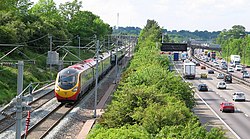This article needs additional citations for verification .(December 2009) |

A transport corridor is a generally linear area that is defined by one or more modes of transportation crossing the limits of more than one city or county like highways, railroads or public transit which share a common destination. Development often occurs around transportation corridors because they carry so many people, creating linear agglomerations like the Las Vegas Strip or the linear form of many neighborhood retail areas.
Contents
A 2019 review and meta-analysis of research into transport corridors found that they improved economic welfare, but had adverse environmental impacts. [1]